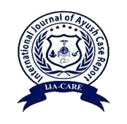Adverse effect due to inhalation of Vatsanabha (Aconitum ferox Wall.) root powder during its processing and its Ayurvedic management: A Case study
Abstract
Vatsanabha (AconitumferoxWall.), in Ayurveda pharmacopoeia, is considered as deadly poison and has been categorized under group of Sthavara visa (poison of plant origin) and the Mahavisha (Potent poison).Pharmacopoeia recommends its use in various formulations after proper Shodhana (processing). A 25 year old female patient, complaining of irritation and burning sensation of the eyes and nasal mucosa, nausea, running nose, vomiting, fever, body ache, abdominal pain, difficulty in breathing, sudden onset menstruation cycle attended the OPD. The patient had a history of normal health, before she carried out Marana (incineration) process ofShodhita (processing) Vatsanabha. She had a precautionary measure of using mask and capduring the powdering of vatsanabha in a mechanical grinder and did not consume the drug orally. Patient was treated with Nasya (nasal administration) of Ghrita Manda (supernatant layer of ghee) (3-4 drops), Sudarshanachurna (5 g) along with warm water thrice in a day, Sitopaladichurna (5 g) along with internal administration of combination of Ghrita (10 ml) and Madhu (5 ml). Patient was observed until all sign and symptoms subsided. Initial symptoms like nasal mucosa irritation & burning sensation, burning sensation of the eyes, vomiting and abdominal pain subsided in two day and fever, running nose, body ache within five days and she had a normal menstruation cycle in next month. Hence, it is concluded that Vatsanabha Shodhana (processing)/Marana (incineration) must be carried out in an open place to avoid inhalation of vatsanabha powder, gloves, mask and cap should be worn. Vatsanabha poisoning through inhalation can be managed by administration Nasya of Ghrita Manda and Snehapana as supportive therapy. It should be administered with caution to the patient during pregnancy

